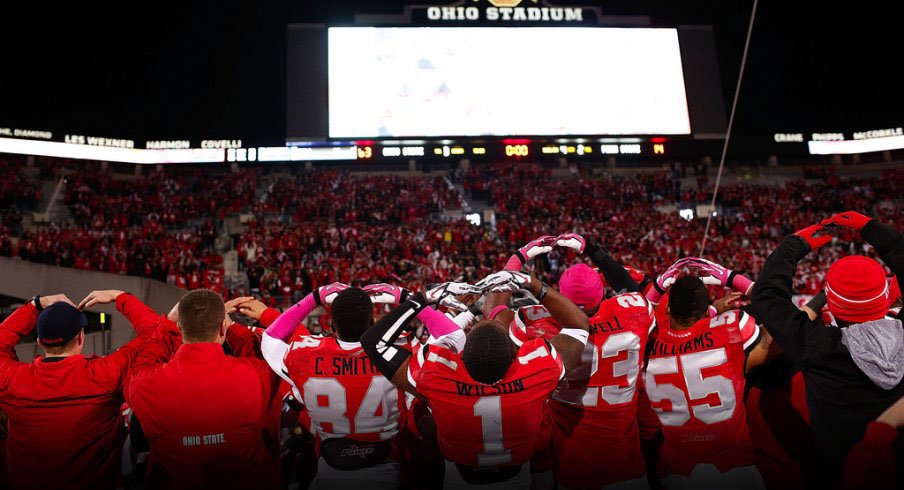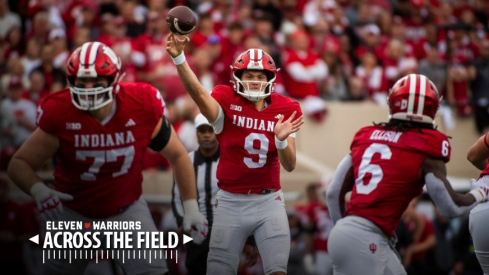In the days before Urban Meyer’s first taste of anxiously pacing up and down the sideline during a nighttime showdown in Ohio Stadium, the then first-year coach implored the scores of fans planning on attending the game to turn the ancient and mighty building into an “inferno.”
The bout — a 25-point blowout of the Nebraska Cornhuskers in 2012 — embodied a larger rebirth of a program that had finally stepped out of the dark shadows of unprecedented turmoil the year before.
On this night, the famed Horseshoe and its record crowd of 106,000-plus was a grand spectacle fitting of this new, flashy era of Buckeye football. The renaissance was on.
But, curiously enough, Ohio State has never sold out of student tickets during Meyer’s young yet dominant tenure in Columbus.
At least not until now.
For the first time in three years, the school filled, and ultimately surpassed, its 28,333-seat allotment for the 2014 season, according to Brett Scarbrough, Ohio State’s assistant athletic director of ticketing and premium seating.
In a climate where student attendance at college football games is declining, the ticketing office sold a total of 29,614 student ticket packages compared to 26,304 in 2013 and 25,798 in 2012 — which is nearly a 15-percent increase over three years.
Thanks to an influx of 2,522 seats to Ohio Stadium’s south stands, roughly 13 percent more students will have the chance to watch Meyer and the Buckeyes next fall while other big-time programs like Georgia and, most recently, Michigan struggle to fill their student sections.
No wonder Ohio State’s two-year dip in numbers fretted Scarbrough and his team.
"It’s been very unexpected the last few years that we didn’t sell out because we had the long streak of just not being able to meet demand"
"It’s been very unexpected the last few years that we didn’t sell out because we had the long streak of just not being able to meet demand," he said.
“We were experiencing that decline as well.”
And while the Buckeyes saw a positive trend upward this year, there’s no guarantee the following year or years to come will be the same. There’s a certain need for schools to be proactive or risk falling victim to an epidemic that’s starting to plague college football.
While it’s a trend without one specific origin or reason, multiple factors lend themselves to today’s widespread decline in student attendance — be it a lousy on-field product, ticket prices, uncomfortable conditions or unpopular rules and regulations.
Success on the field, though, tends to breed success in the box office. So does a competitive and exciting home schedule and so do night games, where the hype surrounding the contest at hand marinates throughout the day before coming to a head under the lights.
There’s a reason for Ohio State’s surge in student tickets: Meyer’s 24-2 in two campaigns and the Buckeyes — which should find themselves in the thick of the national championship picture again this year — host three games in primetime next season before their annual battle with Michigan on Nov. 29 in Columbus.
“I think the prospect to keep on the winning success that we’ve had under coach Meyer the past couple of years is really exciting to people,” Scarbrough said.
But complex problems require complex solutions.
On-field success can only do so much to wage war against a culture shift in how people consume sports with modern advances like high-definition TV, the internet and mobile technology.
“It’s really about the game atmosphere and creating something for them that they can’t get in their basement,” Scarbrough said.
But what they can get in their basement or living room or patio seems to sometimes outweigh what they can get inside a stadium.
“My understanding is that the decline comes mostly from students not going to the games,” Chris Smith, a sports business reporter at Forbes, wrote in an email.
“I don’t think there’s a lack of interest among students, just that it’s easier, and maybe even more fun, to tailgate and then watch the game on a high-def TV within walking distance of a beer-stocked fridge.”
But it means empty seats and thinning student sections.
“There’s a lot of things that you can point at over the past five years: the affordability of large-screen HDTVs and man caves and how much are you competing with that,” Scarbrough said.
“Back when I went to school here, we didn’t have HDTVs, so the experience of being at the game was unmatched. And now, you can get a 70-inch HDTV and you can see it from all angles.”
Ohio State’s countered by changing the way it shows replays on its big-screen scoreboard in the south stands.
Still, fans want more.
“People want to be able to tweet,” Scarbrough said. “They want to be able to instagram.”
So Ohio State is looking seriously at providing fans inside the Horseshoe with WiFi. While there’s no definitive timetable set, Scarbrough said "it’s one of the topics that gets discussed continually" after the school enlisted Verizon Wireless to help with cell phone coverage on game days.
“People say, 'Well I want to be able to have access to WiFi and I want to see stats and I want to be able to put pictures on Instagram ... That is a topic that is getting serious traction right now."
“People say, 'Well I want to be able to have access to WiFi and I want to see stats and I want to be able to put pictures on Instagram' or whatever. That is a topic that is getting serious traction right now,” Scarbrough said.
“They put it in the suites last year as a test program to see if the infrastructure could handle it, to see what the guest experience was like … it got a very positive response, so then how do you take that and magnify it to getting everybody the signal strength they want when there’s 106-107,000 people in there.”
“Obviously it’s a massive expense and undertaking to do something like that, but that is one of the key three to four ingredients that are being looked at right now as a way that we can improve the atmosphere in the stadium and get people out of the basement.”
Other concepts being explored include a committee on the kinds of music you hear over the loudspeakers and visuals like fireworks and other pyrotechnics.
The goal in all of it, though, remains the same.
“It’s about creating the energy that you don’t get in your basement,” Scarbrough said.
Of course, it’s also about providing fans with the best of both worlds. It's about keeping the experience in the stands as powerful as it is on the field.


